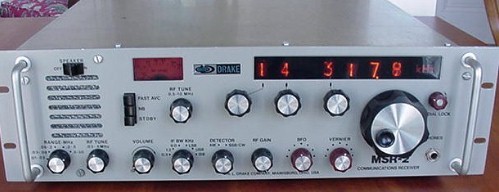|
|
Drake MSR-2 Receiver |
|
|
Drake MSR-2 Receiver |

|
|
The rack-mounted Drake MSR-2 is a laboratory grade marine receiver manufactured in Miamisburg, Ohio, between 1974-78. A table-top version of the receiver, the DSR-2, was identical electrically, except that it lacked the low frequency preselector. The MSR-2 followed the MSR-1 and DSR-1 receivers, manufactured from 1971-74. |
|
|
The left compartment in this top view shows the special tunable low frequency preselector, which gives the MSR-2 outstanding performance in the VLF bands from 10 kHz to 500 kHz. |
||
|
The left rear of this bottom view shows the regulated power supply. Two of the blue 5.645 MHz IF filters are visible at the central rear. The module to the left is the PTO, and the central front module contains the audio amplifier and 5 MHz reference oscillator. |
Design Features: The MSR-2 is semi-synthesized, with various fixed injection frequencies referenced to a 5 MHz master oscillator. Frequency selection is via 10 MHz, 1 MHz, and 0.1 MHz decade switches, with a conventional PTO allowing continuous tuning over the 0 to 0.1 MHz range. The frequency is displayed with six front panel Nixie tubes.
|
|
|
The receiver has IF selectivity bandwidths of 0.3 kHz, 1.2 kHz, 2.4 kHz (USB and LSB) and 6.0 kHz, supplied by five crystal filters. The MSR-2 also features a dual-speed AGC, a highly effective noise blanker, fixed and variable BFO, vernier tuning, and built-in speaker. The MSR-2 shown here is the first production receiver in the line. It has a serial number of 251 (0-250 was assigned to the MSR-1).
|
||
|
In addition to the antenna input, the rear panel of the MSR-2 has jacks for the 50 kHz IF output, receiver muting, and an external speaker. A terminal block provides two 600 ohm balanced audio outputs, a speaker output, and a low-level independent sideband output. |
||
|
Operating Impressions: The MSR-2 is a fine receiver, and the noise blanker is one of the best I've ever used. The Nixie tube displays are easier to read than modern LCD and LED displays. The digital frequency selection is a bit clunky by modern standards, but works well. The best performance feature of the MSR-2 is its VLF capability. The tunable preselector covers 10-500 kHz in four bands and renders the receiver virtually immune to front-end overload. The receiver can withstand 1000 volts of peak RF voltage without damage. |
||